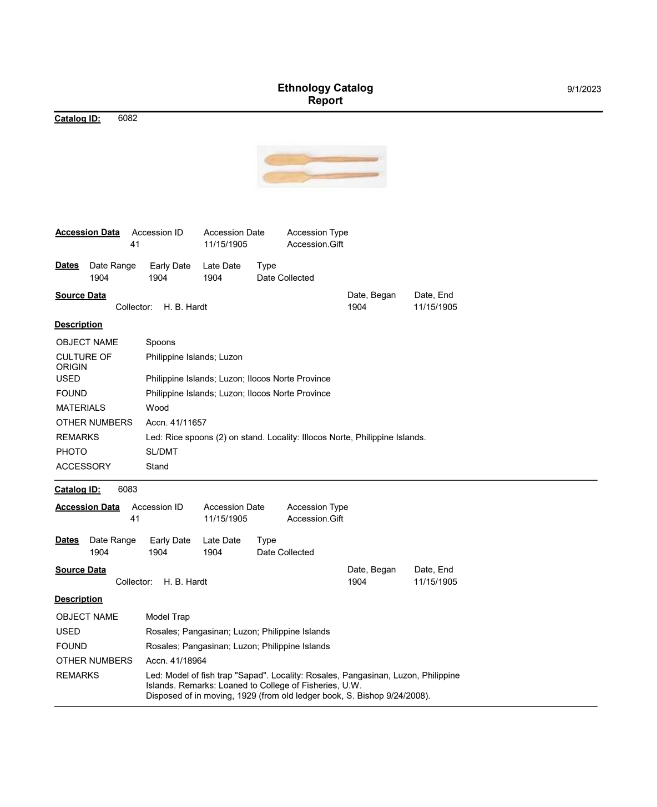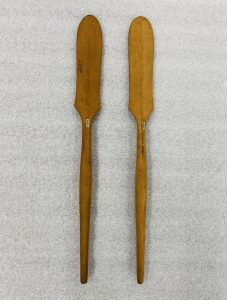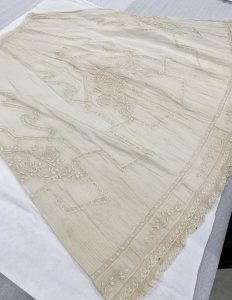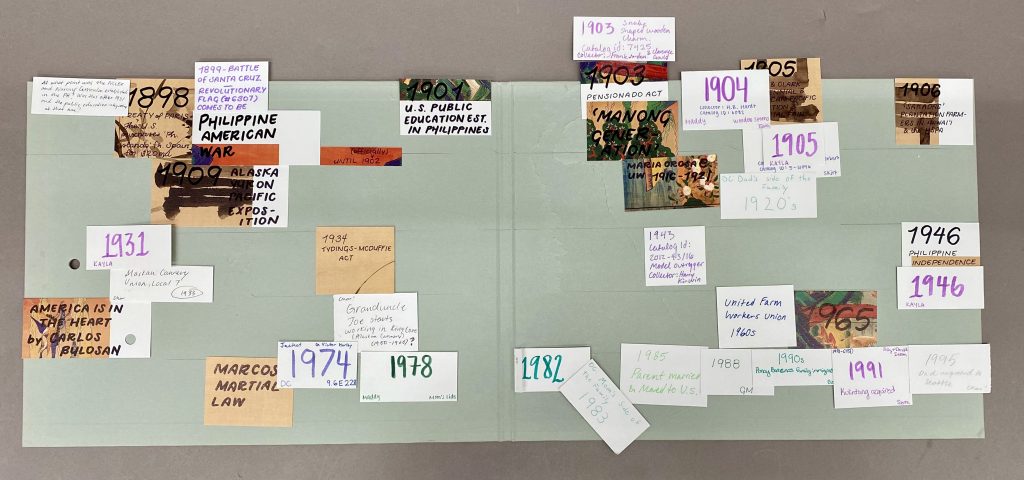Activities
One thing that I appreciate about Knowledge Kapamilya is that it is not like a regular class. What makes it interesting is that sessions are held in the Burke Museum. By being in Knowledge Kapamilya, I’ve had the opportunity to explore other areas of the museum that aren’t always open to the public, such as Collections. Collections is one of the rooms where many of the cultural artifacts that aren’t on display for the public are stored. One of our first activities in Knowledge Kapamilya was “Galavanting through Collections.” During this activity, we entered the Collections room and explored some of the cultural belongings, such as musical instruments, weapons, and textiles.
In a session following our exploration of Collections, another activity we did focused on researching a specific cultural belonging. Our facilitator, Gabbie, shared a catalog of all the Philippine cultural belongings that the Burke Museum had and we were tasked with choosing one to two items that we found interesting. The first item that I chose was a pair of rice spoons that originated in the Ilocos Norte Province of Luzon.

This item was acquired from H.B. Hardt in the early 1900s. H.B. Hardt was the Chief Clerk of the Department of Exhibits at the Lewis and Clark Exposition held in Portland, Oregon in 1905[2]. This worldwide exposition was created to celebrate the centennial of the Lewis and Clark Expedition[3].

Hardt was the superintendent of the “Philippine Exhibit” that was displayed at the exposition and would eventually sell the artifacts that were part of the collection to the University of Washington for $1,000 ($1,000 in 1905 is worth almost $35,500 today)[4]. I wanted to choose an item that originated from Ilocos Norte because that is where my mom is from. She was born in Ilocos Norte and lived there for seven years before she immigrated to the United States and lived in Hawaii for the rest of her childhood. Later in life, she moved with me and the rest of my family to Washington where we have lived for the past 17 years. When I searched the catalog for cultural belongings from Ilocos Norte the rice spoons were the only item to show up. One of my first questions was, why aren’t there more artifacts from Ilocos Norte?

The other cultural belonging I chose was a skirt made from piña cloth. This item originated from Manila, Luzon which is where my grandmother is from. This was part of the reason why I chose it. In addition, it reminded me of the costumes that we wear in Sayaw.
Over the course of a few sessions, we were able to further analyze our cultural belongings and physically examine them in the Burke Museum’s Workroom. During this time, we logged notes, took pictures, and learned more about the cultural belongings that others chose. This would ultimately lead to our next multi-session activity which was creating a timeline. On the timeline, we recorded a few key dates in Filipino American history, such as the 1898 Treaty of Paris during which the US purchased the “Philippine Islands” from Spain for $20 million, and the 1903 Pensionado Act which was established to “educate young Filipinos in the US so they could acquire a thorough knowledge of Western civilization”[5] that they would bring back to the Philippines.

We also personalized the timeline to our group by adding important dates from our personal history, such as when our families immigrated from the Philippines to the US. And finally, we included the dates of our cultural belongings. After filling out the timeline with the information that we gathered, we took a moment to notice spots that were missing information and tried to fill in the gaps. These gaps were mainly throughout the 1930s-1950s. We asked ourselves if we knew any key events that took place in the somewhat empty areas of the timeline. Overall, the timeline activity was an interesting way to illustrate a series of key events in Filipino American history at a high level as well as our individual histories at a more personal level, and see how these events are connected.
- Ethnology Report Catalog. 15 November 1905. Catalog ID No. 6082. Accession Records, Burke Museum, University of Washington, Seattle, WA. ↵
- Washington Commission Bill of Sale. 14 November 1905. Accession No. 41. Accession Records, Burke Museum, University of Washington, Seattle, WA. ↵
- Abbott, Carl. 2004. “Lewis and Clark: From Expedition to Exposition, 1803-1905.” Oregon History Project. https://www.oregonhistoryproject.org/articles/lewis-and-clark-centennial-and-american-pacific-exposition-and-oriental-fair/ ↵
- Webster, Ian. 18 May 2024. “$1000 in 1905 → 2024 | Inflation Calculator.” Official Data Foundation, Alioth Finance. https://www.in2013dollars.com/us/inflation/1905?amount=1000 ↵
- Rivas, Mekita. 2012. “A Legacy of Education.” Nebraska Alumni Association. https://www.huskeralum.org/s/1620/magazine/interior.aspx?sid=1620&gid=1&pgid=3095#:~:text=According%20to%20Theo%20Gonzalves%2C%20curator,knowledge%20of%20Western%20civilization%E2%80%9D%20and ↵

